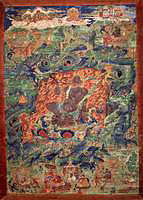
|
Mahakala (painting no. 343)
|

View Larger Image |
||||||||||||||
|
Brahmarupa Mahakala (Tibetan: gon po dram ze, English: the Mahakala who appears in the form of a Brahman). Appearing as an Indian Brahman, dark brown in colour, he has one face and two hands. With the right hand he blows on a deer horn trumpet and with the left supports himself on the cushion while holding a white bone mala (string of prayer beads). The hair, beard and eyebrows are orange and flame upward like fire. Wearing bone ornaments and silks he sits in a relaxed posture on a deer skin mat, sun disc and lotus. At the edges of the primordial wisdom fire emanating from his form are four dakinis hovering in the air, blue, yellow, green, and red. They are naked with disheveled orange hair, each holding a curved knife and skullcup. Placed in front of the lotus are a trident, sword and a curved knife and skullcup atop a vase. Seated at the mouth of a cave surrounded by wild, blue-black, rocky outcroppings he is surrounded by smaller wrathful figures and residing in a cave to the left, a solitary lama, wearing a pandita hat. Directly above, floating on the clouds, is Manjuvajra Guhyasamaja, orange, with three faces and six hands embracing the consort. To the right is a celestial palace with Avalokiteshvara standing in front accompanied on each side by White and Green Tara. At the far left a Lama on a throne teaches to a group of four students seated to the sides. The upper and lower backgrounds of the painting portray a placid green landscape. Again, near to the top on the left and right and on the bottom left and right are small representations of the central Brahmarupa Mahakala. These four show variation in posture, colour and hand objects. At the bottom center is an older lama wearing monastic robes, holding a vajra and bell, seated on an elaborate throne. In front and to the side are a six students; with offerings arranged on a shrine table and an elaborate torma (stylized food offering) in the middle. Short History: When the great Tibetan Translator Nyen Lotsawa received the Manjuvajra Guhyasamaja (also known as the Jnanapada Lineage) empowerment from the dakini Risula, she also bestowed the initiation of the Mahakala (Caturmukha) in the special form according to the Guhyasamaja Tantra. At this time she gave him as a servant a dark skinned Brahman. When Nyen Lotsawa and the Brahman reached Nepal the servant changed appearance and took on the form of a monk, an appearance more conducive for travelling in Tibet. After the passing of Nyen Lotsawa the monk remained with Lama Nam Ka'upa and then later with Sachen Kunga Nyingpo. Brahmarupa Mahakala is none other than Caturmukha Mahakala of the Guhyasamaja Tantra. In his wrathful appearance he is black in colour with four faces and four hands, surrounded by the four dakinis. In the Sakya School it is inappropriate to show the wrathful form to anyone who has not received the initiation. For this reason the iconographic tradition arose for painting Caturmukha in the form of the Brahman servant of Nyen Lotsawa. At the bottom of many Sakya 'thangkas' it is a common theme to see Panjarnatha Mahakala flanked by the Brahman on the right and Sri Devi (Palden Lhamo) on the left - the three main protectors of the Sakya School. Indian Lineage: Vajradhara, Nagarjuna, Balimtapa, Buddhajnana, Marmedze Zangpo, Shrideva, Drime Bepa, Ratnavajra, Ratnakirti, Risula Dakini, Nyen Lotsawa, Lama Nam Ka'upa, Sachen Kunga Nyingpo, etc. J.Watt 6-98
|
|||||||||||||||
Photographed Image Copyright © 1998 Shelley & Donald Rubin Foundation
|
|
| |
Next Image |